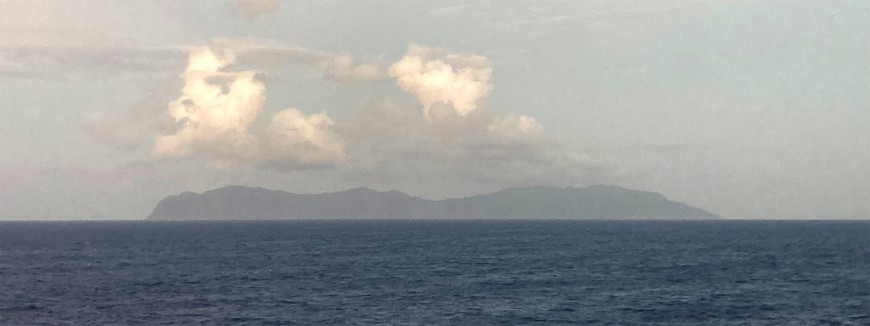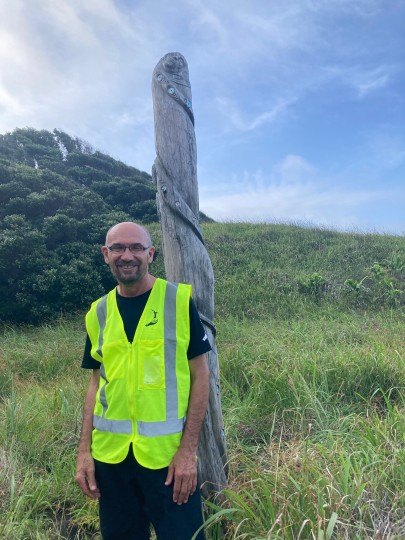Tō tātou hā i te tuatahi ko te moana, hā tuarua nō tātou te whenua
Our first breath is from the ocean, our second from the land
– Ngāti Kuri whakataukī.

Rangitāhua Island from the sea.
Halfway between Aotearoa New Zealand and Tonga lie Rangitāhua (the Kermadec Islands), a volcanic group of islands rich in biodiversity and taonga to Ngāti Kuri. They have been scientifically identified as one of only four pristine marine ecosystems on Earth.

Peter Bellingham beside a pou whenua (boundary marker) that Ngāti Kuri kaumātua installed on Rangitāhua in 2001.
Manaaki Whenua senior researcher Peter Bellingham recently travelled to Rangitāhua aboard the Navy vessel HMNZS Canterbury. The January voyage took place mid-way through a 5-year MBIE Endeavour programme called ‘Te Mana o Rangitāhua’, which Ngāti Kuri co-leads with Auckland Museum, with support from Manaaki Whenua, Massey University, NIWA, the University of Auckland, Auckland University of Technology and the University of Waikato.
The programme aims to identify tohu (signs) of ecosystem change and to develop methods to ensure the long-term well-being and resilience of ecosystems of Rangitāhua. Through Treaty settlement, Ngāti Kuri have co-governance of the islands and are re-engaging with them through the connections of their tūpuna.
The group spent 5 days on the largest island of Rangitāhua, with Peter’s role being to assist in understanding the ecology of the forests and other ecosystems of the island and contribute to dialogue about future management plans. Representatives from the Department of Conversation, MetService and GNS Science were also present to undertake their own work and infrastructure projects.
Peter says it was a privilege to be part of the Ngāti Kuri conversations and discoveries about their connections to the island plants, birds, and other animals. “Rangitāhua has never been connected to a larger landmass, and it has a unique subtropical ecosystem. In its isolation, it has evolved a unique biodiversity, above and below the waterline.”
Peter highlights the island’s precariousness: it is an active volcano, it is subject to powerful earthquakes and cyclones, and it is vulnerable to introduced species such as goats, cats, and Norway rats. “These mammal pests are now all eradicated, but the ecosystems were devastated and radically altered, and are only now recovering. For example, rats and cats decimated seabird populations by 2000, but black-winged petrels have since recolonised and are now abundant,” he says.
Reflecting on the voyage, Peter says “In my career, I’ve been lucky to see many different island ecosystems, but the cultural perspective on this trip gave me entirely new insights.
“The main benefit for me of the trip was to be part of seeing and learning about the moutere from Ngāti Kuri’s viewpoint and to see their manifestation of mana motuhake (sovereignty and self-determination) on Rangitāhua. A next step for me will be supporting Ngāti Kuri to give some of these plants names to reflect the plants’ important part of their history there.”
Strategic lead of the Ngāti Kuri Trust Board, Sheridan Waitai says there are many who could learn from Peter by the way he works with iwi, hapū, and whānau. “Peter has strengthened the wider relationship with Manaaki Whenua, and for us it was an honour to take him and hold him as part of our family. Rangitāhua needs many hands and minds to help transform the environment into to a thriving space, and we look forward to working with the multitudes to do this.”



![A tropical seashore member of the pea family that has a scientific name ([Canavalia rosea]) but currently lacks a name in te reo Māori. Image](/assets/Publications/Putaiao/putaiao-issue-14/Canavalia__FitMaxWzE1LDE1XQ.jpg)
